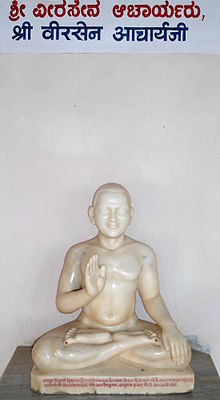Acharya Virasena (792-853 CE),[1] also known as Veerasena, was a Digambara monk and belonged to the lineage of Acharya Kundakunda.[2] He was an Indian mathematician and Jain philosopher and scholar. He was also known as a famous orator and an accomplished poet.[3] His most reputed work is the Jain treatise Dhavala.[4] The late Dr. Hiralal Jain places the completion of this treatise in 816 AD.[5]
Acharya Shri Virasena Ji Maharaj | |
|---|---|
 Acharya Virasena | |
| Personal | |
| Born | 792 CE |
| Died | 853 (aged 60–61) |
| Religion | Jainism |
| Sect | Digambara |
| Notable work(s) | Dhavala |
| Religious career | |
| Predecessor | Aryanandi |
| Successor | Jinasena |
Virasena was a noted mathematician. He gave the derivation of the volume of a frustum by a sort of infinite procedure. He worked with the concept of ardhachheda: the number of times a number can be divided by 2. This coincides with the binary logarithm when applied to powers of two, but gives the 2-adic order rather than the logarithm for other integers.[6][7]
Virasena gave the approximate formula C = 3d + (16d+16)/113 to relate the circumference of a circle, C, to its diameter, d. For large values of d, this gives the approximation π ≈ 355/113 = 3.14159292..., which is more accurate than the approximation π ≈ 3.1416 given by Aryabhata in the Aryabhatiya.[8]
Life
editVirasena was proficient in astrology, grammar, logic, mathematics and prosody. He wrote Dhavala, a commentary on Jain canon Shatakhandagama. He also started the work on Jayadhavalaa which was completed by his disciples. He was among the jewels of Rashtrakuta king Amoghavarsha.[9]
His lineage started with Chandrasena who initiated Aryanandi.[10] Aryanandi initiated Virasena and Jayasena.[10] Virasena initiated six disciples who were Dasharayguru, Jinasena, Vinayasena, Shripal, Padmasena and Devasena.[10] Dasharayguru and Jinasena initiated Gunabhadra who later initiated Lokasena.[10] Vinayasena initiated Kumarasena who started the Kashtha Sangha.[10]
See also
editReferences
editCitations
edit- ^ Jaini 1991, p. 111.
- ^ Indranandi. Shrutāvatāra
- ^ Jinasena. Ādi Purāņa
- ^ Satkhandagama : Dhavala (Jivasthana) Satparupana-I (Enunciation of Existence-I) An English Translation of Part 1 of the Dhavala Commentary on the Satkhandagama of Acarya Pushpadanta & Bhutabali Dhavala commentary by Acarya Virasena English tr. by Prof. Nandlal Jain, Ed. by Prof. Ashok Jain ISBN 9788186957479
- ^ Nagrajji, Acharya Shri (2003). Agama and Tripitaka: Language and Literature. Concept Publishing Company. p. 530. ISBN 9788170227311.
- ^ See, e.g., Shparlinski, Igor (2013), Cryptographic Applications of Analytic Number Theory: Complexity Lower Bounds and Pseudorandomness, Progress in Computer Science and Applied Logic, vol. 22, Birkhäuser, p. 35, ISBN 978-3-0348-8037-4.
- ^ Gupta, R. C. (2000), "History of Mathematics in India", in Hoiberg, Dale; Ramchandani, Indu (eds.), Students' Britannica India: Select essays, Popular Prakashan, p. 329
- ^ Mishra, V.; Singh, S. L. (February 1997), "First Degree Indeterminate Analysis in Ancient India and its Application by Virasena" (PDF), Indian Journal of History of Science, 32 (2): 127–133, archived from the original (PDF) on 29 November 2014, retrieved 17 September 2014
- ^ Natubhai Shah 2004, p. 31.
- ^ a b c d e Pannalal Jain 1951, pp. 30–31.
Sources
edit- Jain, Pannalal, ed. (1951), Mahapurana Adipurana of Bhagavata Jinasenacharya, Bharatiya Jnanapitha
- Jaini, Padmanabh S. (1991), Gender and Salvation: Jaina Debates on the Spiritual Liberation of Women, University of California Press, ISBN 0-520-06820-3
- Shah, Natubhai (2004) [First published in 1998], Jainism: The World of Conquerors, vol. I, Motilal Banarsidass, ISBN 81-208-1938-1
External links
edit- Media related to Virasena at Wikimedia Commons
- Singh, A. N. "Mathematics of Dhavala". Lucknow University. Translation of part of the Dhavala.